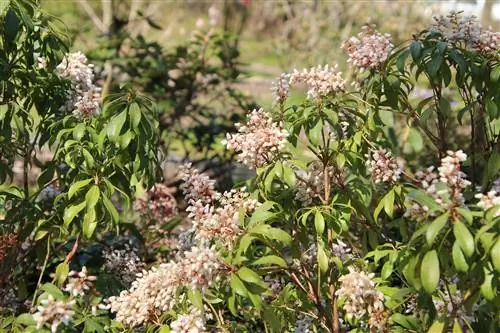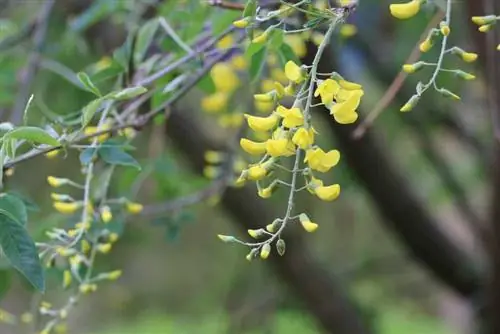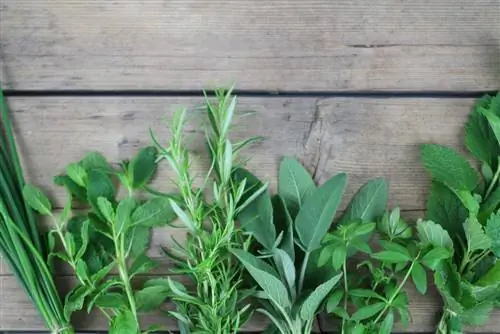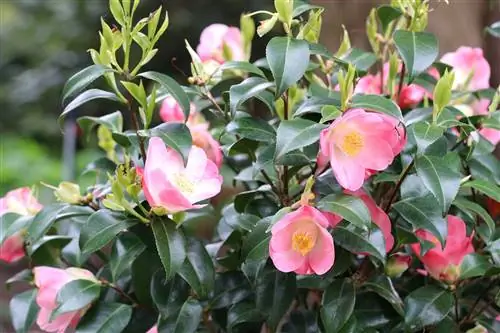- Author admin [email protected].
- Public 2023-12-17 03:39.
- Last modified 2025-01-24 12:45.
When the plants in the garden have dropped their fruits and seeds and the leaves gradually wither, then the time of evergreen shrubs begins. They give the garden structure even in winter and take away some of the dreary atmosphere of the gloomy season. Many shrubs are ideal as hedges and can also be refined with topiary cuts. However, not every shrub is suitable as a hedge plant due to their different requirements.
Site conditions
The selection of evergreen shrubs is huge and seems to never end. However, the choice is severely limited by the prevailing location conditions in your garden. Not every plant is equally suitable for every location. The most important aspect is solar radiation. Many shrubs can be planted in sunny locations. However, some species prefer shady places. Another aspect is the space factor. The shrubs need space so that they can spread without restriction. Last but not least, the growth of the plants also plays a role. If you want to create an opaque hedge, you should choose fast-growing species.
Tip:
Cut the hedge in spring before budding and in autumn before the first frost. In this way, the plant develops many small shoots inwards and the hedge becomes opaque more quickly.
Shadow plants
These plants are adapted to low-light conditions with less than three hours of sunlight per day.
Shadow bells (genus Pieris)
These plants are a real eye-catcher in the garden, and not just because of their evergreen leaves. They form inflorescences that envelop the garden in a colorful sea of flowers. Of the ten different species, Pieris floribunda and japonica are primarily planted in the garden. The Japanese species (Pieris japonica) produces hanging flower spikes, while the species from North America (Pieris floribunda) develops upright inflorescences. The shadow bell is also suitable for semi-shady locations.
Tip:
Shadow bells grow very slowly and reach maximum heights of 150 cm. Therefore, place the plant in hard-to-reach locations because it does not need to be pruned.
Grape heaths (genus Leucothoe)
This genus includes, for example, the variegated laurel jug. It grows best near a pond. The species in this genus are characterized by the fact that they change their leaf color in winter. As it gets colder, the green color of the leaves gives way to a red to purple hue. Next spring the leaf color changes to green again. However, the discoloration is increased by the incidence of light. It is stronger in partially shaded locations than in shady places.
Camellia (Camellia japonica)
This species loves the cold season because when the temperatures drop, it is at its best. Between January and March it develops its large flowers, which shine in the colors white, pink or red. However, the plant must be protected from sunlight in winter, otherwise the leaves will dry out. A layer of mulch prevents the roots from being damaged by frost.
Skimmia (Skimmia japonica)
The skimmie is a real splash of color in your own garden. The plant, which comes from the mountainous regions of Japan, produces its red inflorescences from October onwards, which bloom throughout the winter. The hardy plant should always be kept moist, especially in summer.
Tip:
A layer of mulch is a natural moisture store. This means the roots are optimally protected from drying out.
Holly (Ilex aquifolium)
This shrub reaches heights of between three and four meters, making the evergreen shrub a popular hedge plant. When young, the aesthetically shaped leaves have small spines. The white flowers develop into a sea of red colors in autumn. The fruits last until spring, but are poisonous.
Sunflowers
Sunny locations are characterized by exposure to light for more than six hours a day. Characteristic of such habitats is the strong sunlight, especially during midday. Shade plants burn in these extreme locations.
Laurel-leaved viburnum (Viburnum tinus)
The viburnum is a popular plant due to its special properties. Their flowering period extends from November to April. During this time it develops large, white flowers that enrich the garden with a fragrant scent. The tree can reach a height of 350 cm. However, the plant is not suitable for harsh winter regions. It is extremely sensitive to frost and reacts sensitively to waterlogging. The snowball can also be planted in partially shaded locations.
Tip:
If you don't want to miss out on the beautiful shrub, then cultivate the plant in a bucket. This can be spent in a sheltered place in the winter garden during the cold season.
Firethorn (genus Pyracantha)
The species in this genus reach heights of up to 6 m. When cut regularly, the tree forms an opaque hedge. The white racemose inflorescences are produced from April to May. In October, countless berries develop on the bushes. Depending on the species, the color of the berries can vary from yellow to orange to red. They provide an important source of food, especially for birds in the cold season. It's not just the blaze of color that makes firethorn a popular garden plant. It is also particularly easy to care for.
White variegated scented flower (Osmanthus heterophyllus 'Variegatus')
This plant produces leaves similar to those of the widespread holly. Between September and October it develops its white flowers, which grow in clusters and exude a wonderful scent. The plant owes its name to the fact that it has shimmering green leaves with white edges. So far this species is still considered a real insider tip. It is particularly suitable for Japanese-style gardens.
Colourful olive willow (Elaegnus pungens)
A popular evergreen shrub for sunny locations is the olive willow due to its colorful leaf coloring. The leaves have greenish to yellow tones and are very bright. The creamy white flowers are produced between October and November and spread a wonderful scent. The plant also thrives very well on sandy soils. However, it is extremely sensitive to wind.
Evergreen dwarf magnolia (Magnolia grandiflora “Nana”)
This evergreen shrub produces beautiful large flowers in a bright white. They also provide a seductive scent. The plant prefers sunny locations and a mild climate. Its leaves shimmer in a dark green.
Frequently asked questions
What do I need to consider before buying?
The location conditions are crucial. The selection of shrubs depends on the incidence of light, soil permeability and soil moisture. Also consider the space the shrub needs to grow.
Do the bushes need to be cut back?
Species that grow quickly should be pruned regularly. This causes them to form an opaque mass of foliage. Slow-growing species can be trimmed with scissors from time to time.
More evergreen shrubs coming soon
- Korean fir: The Korean fir (Abies koreana) offers an extremely interesting eye-catcher with its numerous cones, which initially appear purple to crimson and later turn brownish. They add color to the garden even in the sometimes dreary late autumn. The green needles of this fir tree, which shimmer silver on the underside, are also attractive.
- Cherry juniper and skimmie: We can enjoy the fresh green of the plants not only in spring. The cherry juniper “Moonlight” retains its bright color all year round. The skimmia 'Rubella' also helps us get through the dreary months with its deep red flowers and its dark green leaves.
- Sugarloaf spruces: Sugarloaf spruces grow very densely even without regular pruning. They do not need any winter protection and can therefore be decorated for winter at any time with bows or fairy lights.
- Privet: With patience and caution, it is not difficult to form beautiful balls or cones out of privet. Homemade wooden scaffolding covered with wire serves as a template. You will see. Soon you will also dare to create artistic animal figures
- Juniper: Junipers are undemanding evergreens with many faces. While varieties like 'Compressa Aurea' or 'Barmstedt' grow slenderly upright, 'Blue Carpet' likes to hang over the edge of a trough.
- Rhododendron: Rhododendron bushes not only attract attention when they are blooming in April and May. Even in winter, its dark green, shiny foliage is a ray of hope. Don't worry if the leaves curl in the cold, a natural protection against drying out in winter.
- Box: These all-rounders are always in top shape as balls, cones or figures, in the garden or in pots next to the front door.
- Yew: The red fruits are a beautiful contrast to the rich color of the densely grown yew tree.






